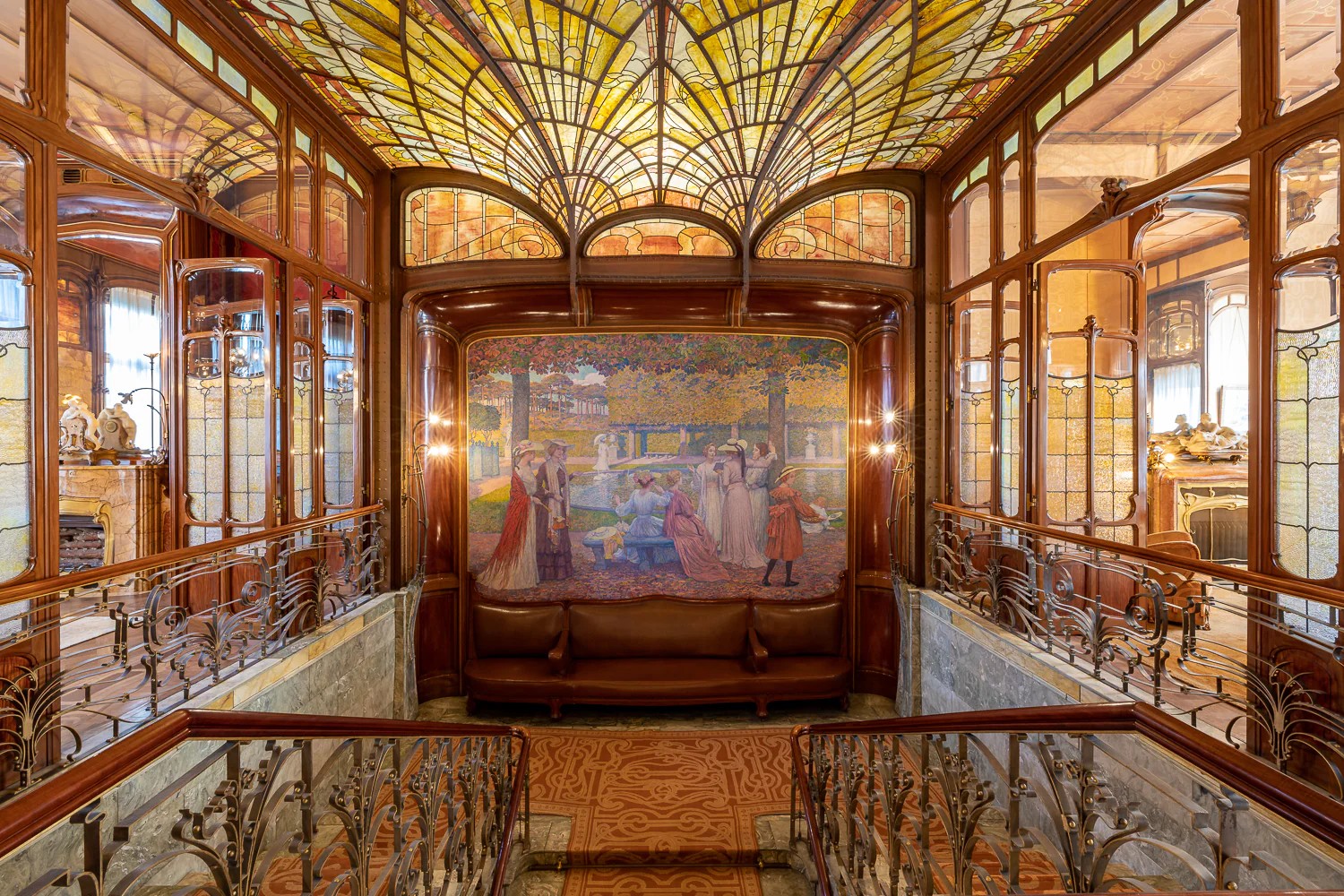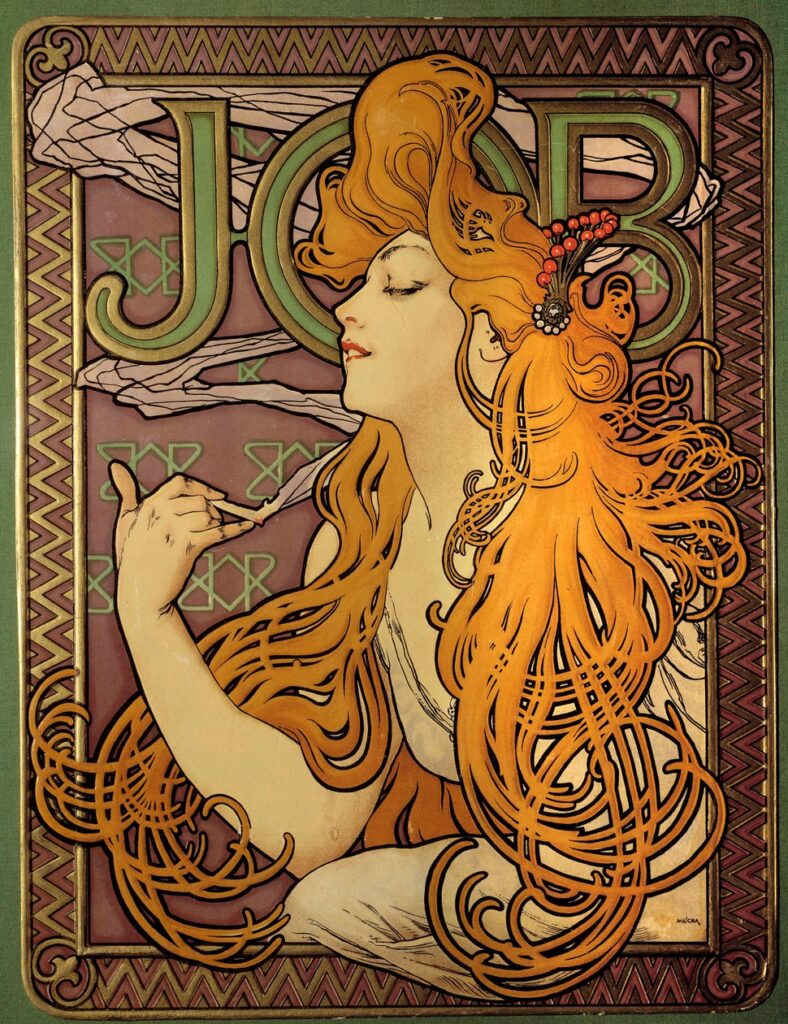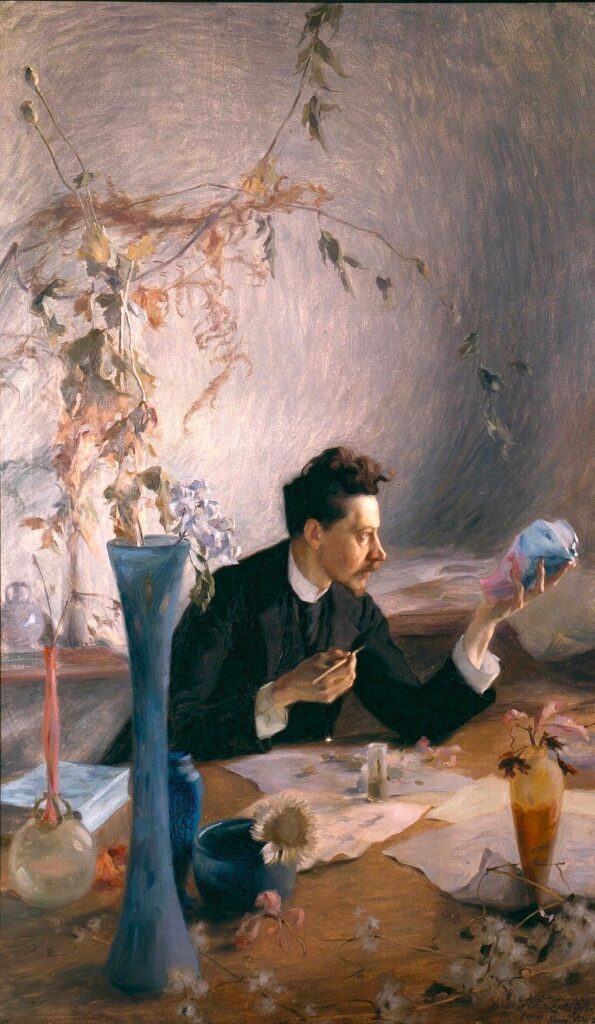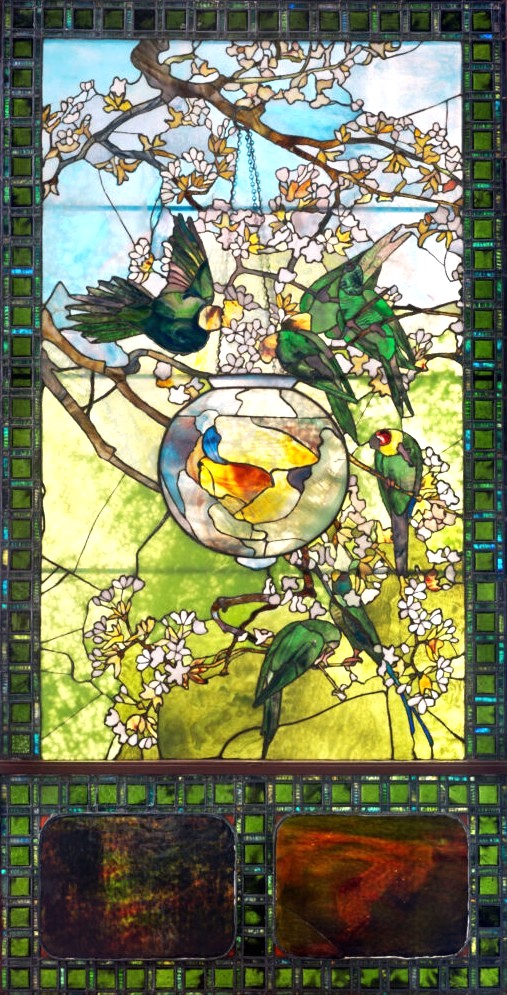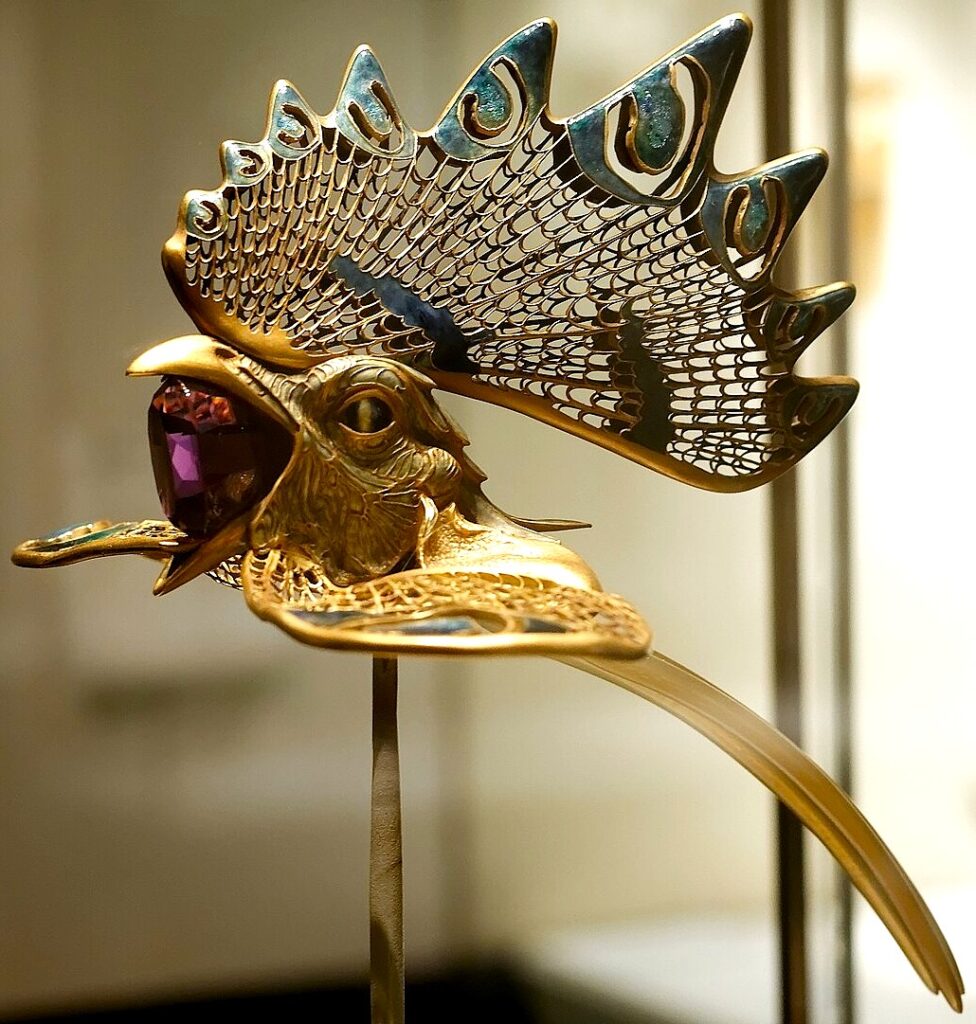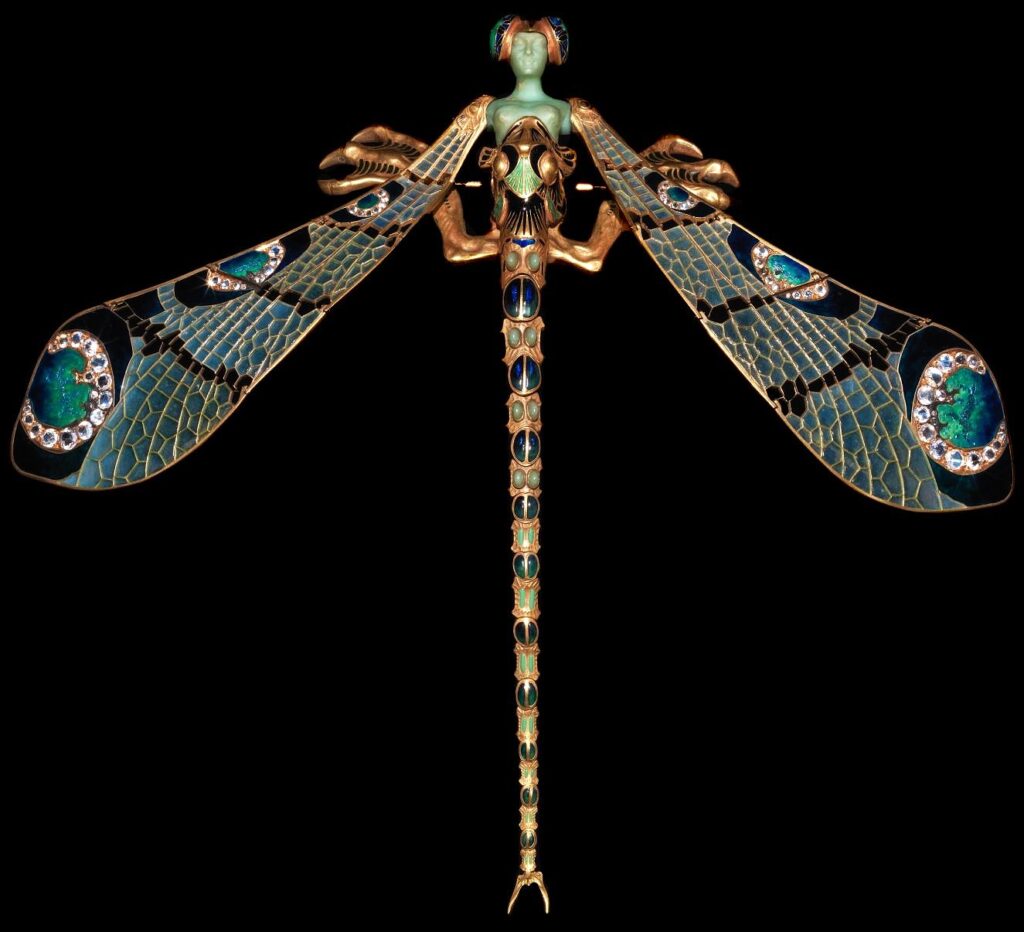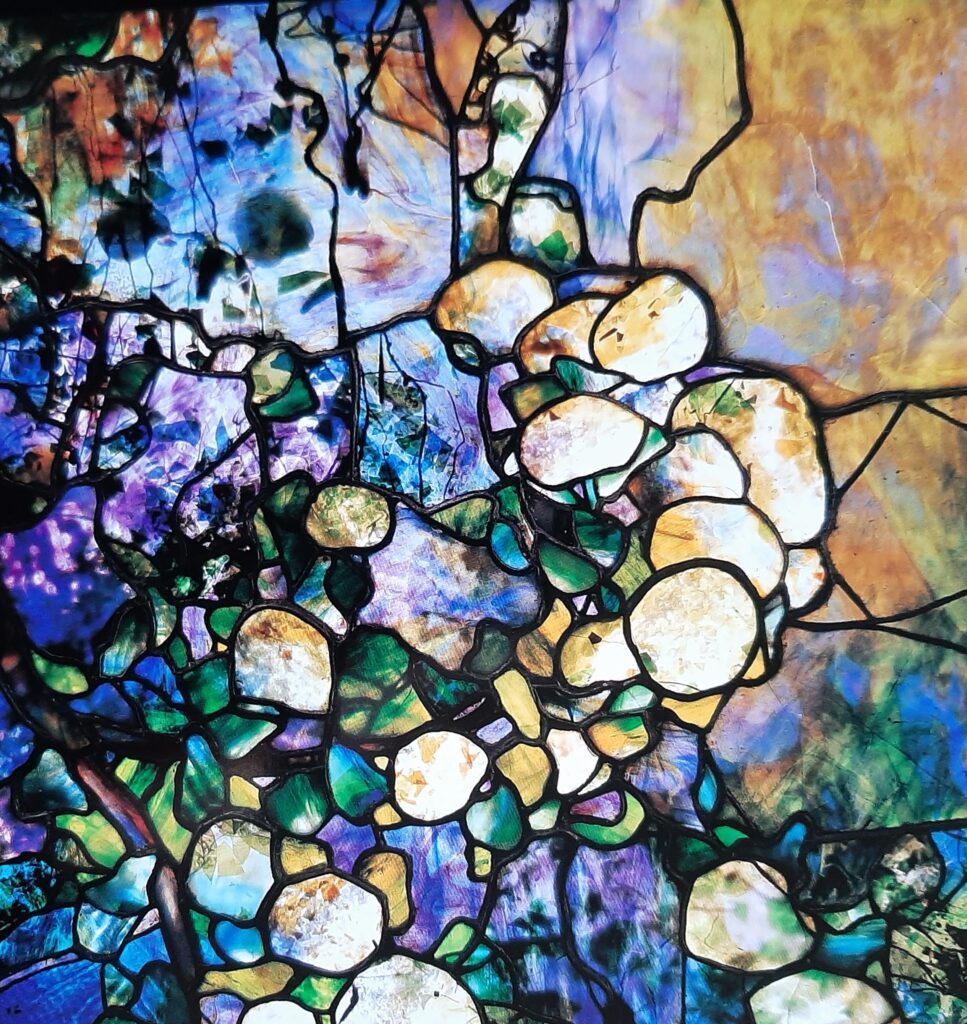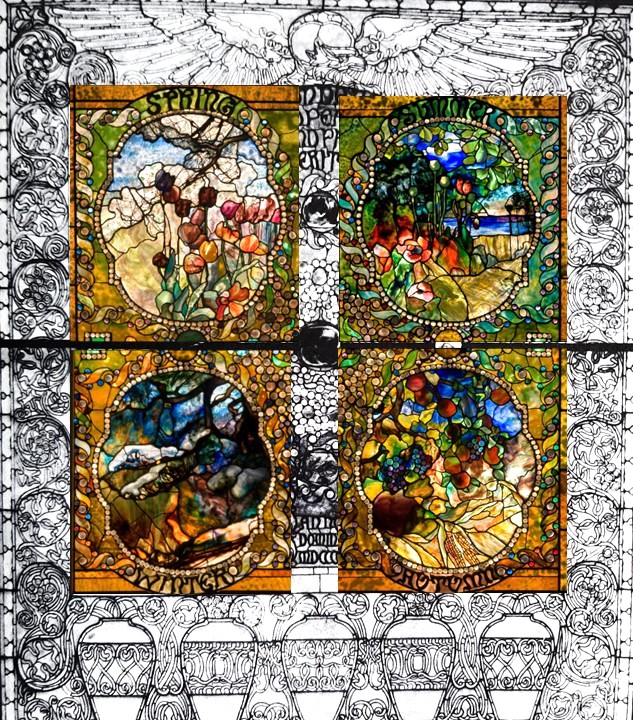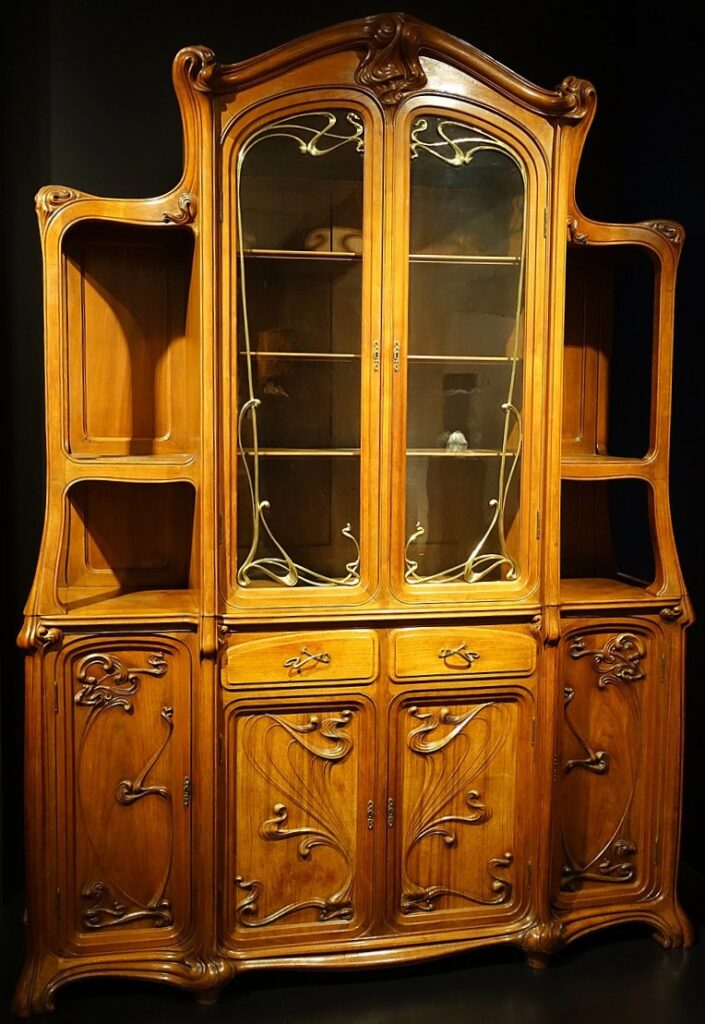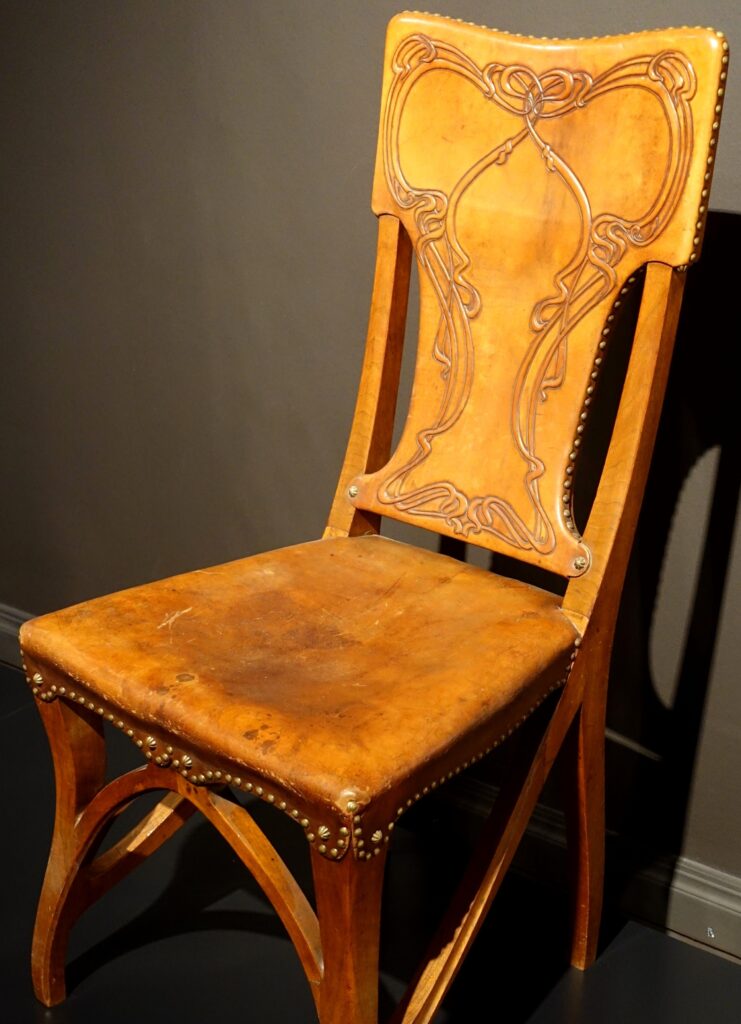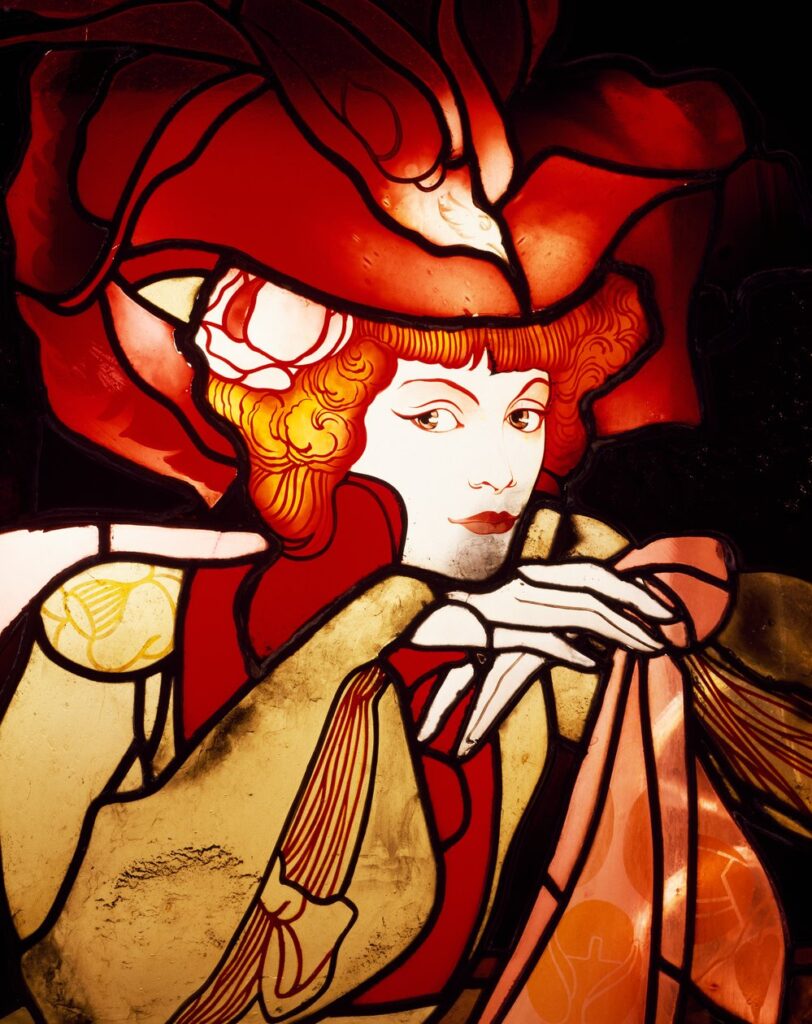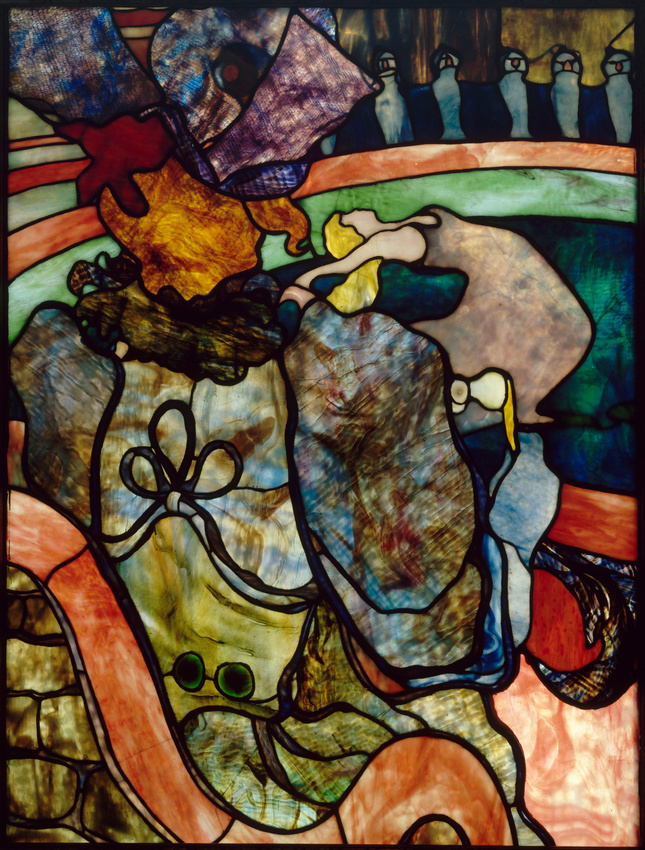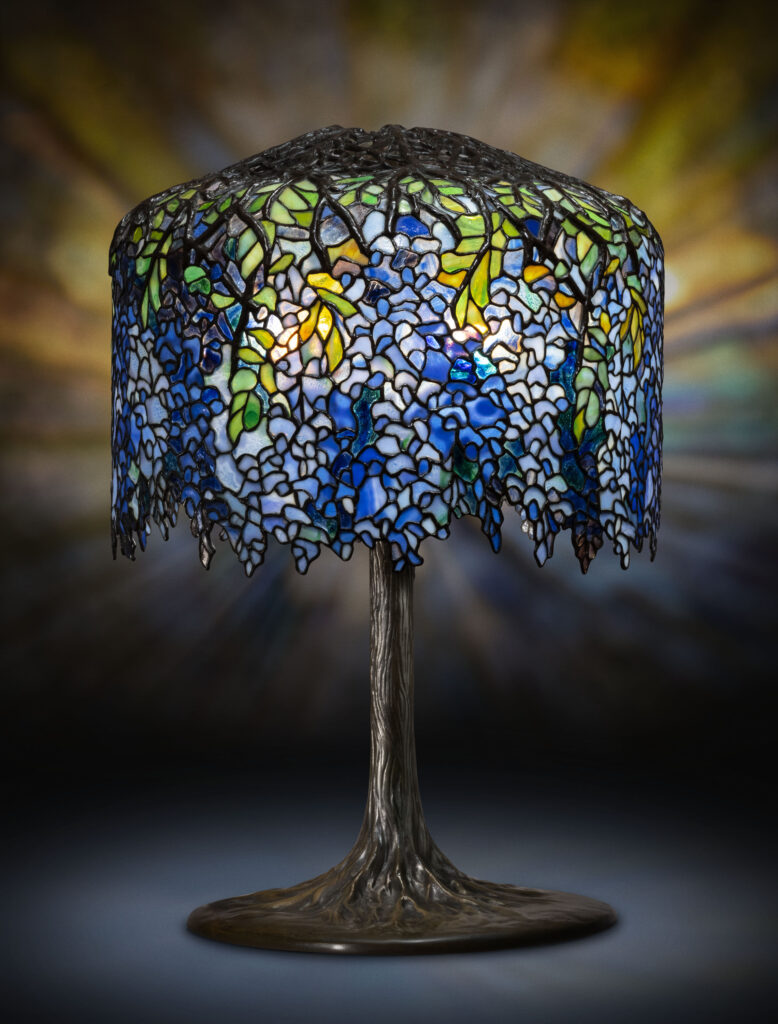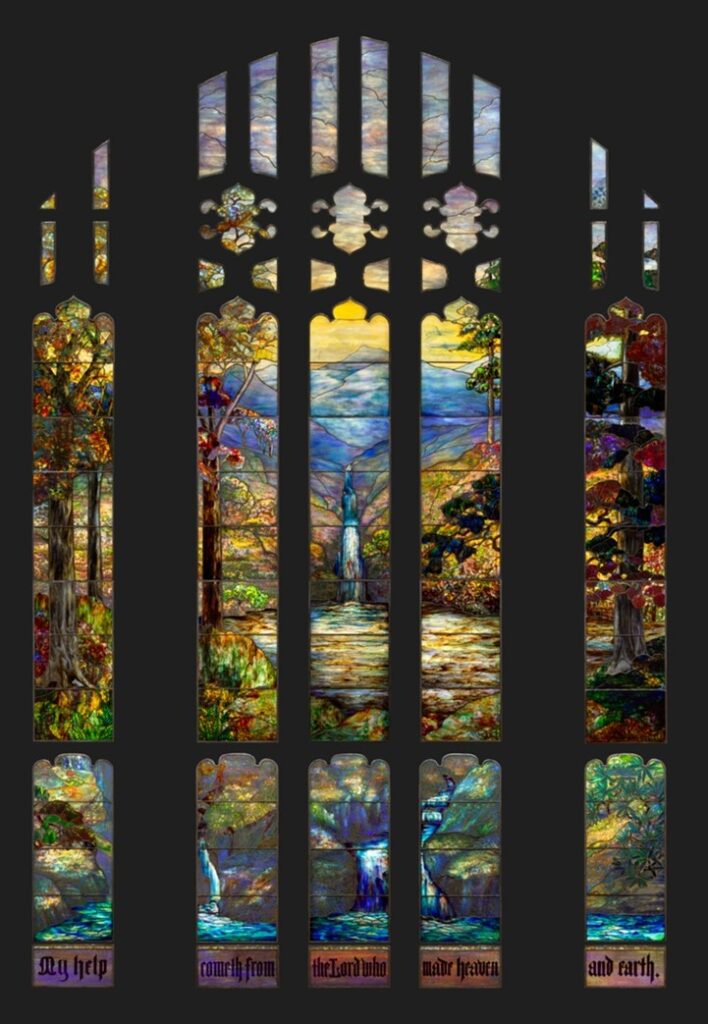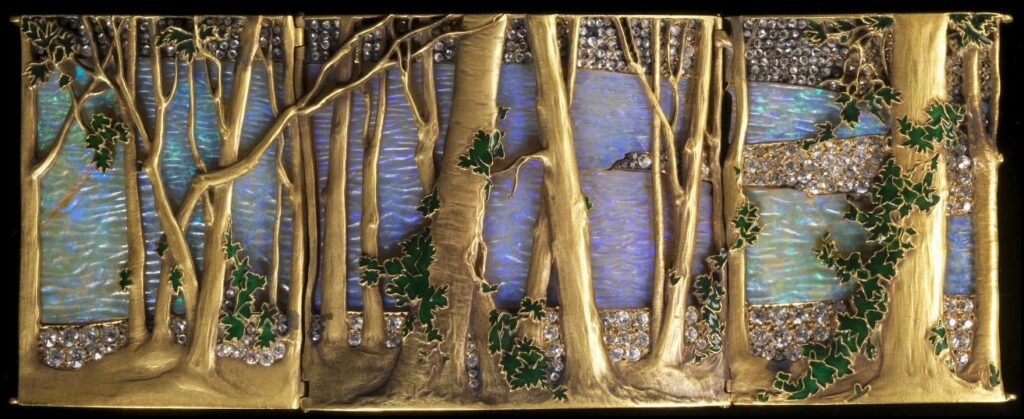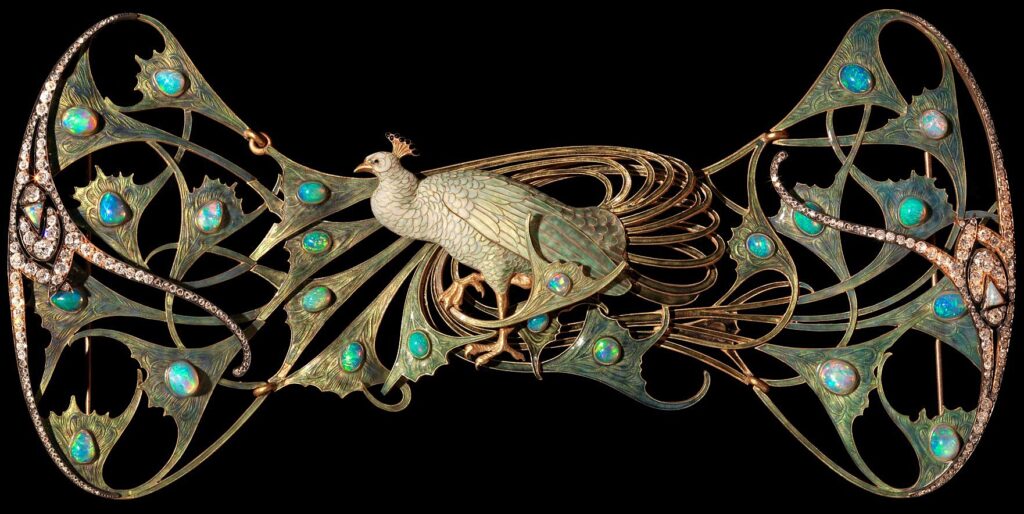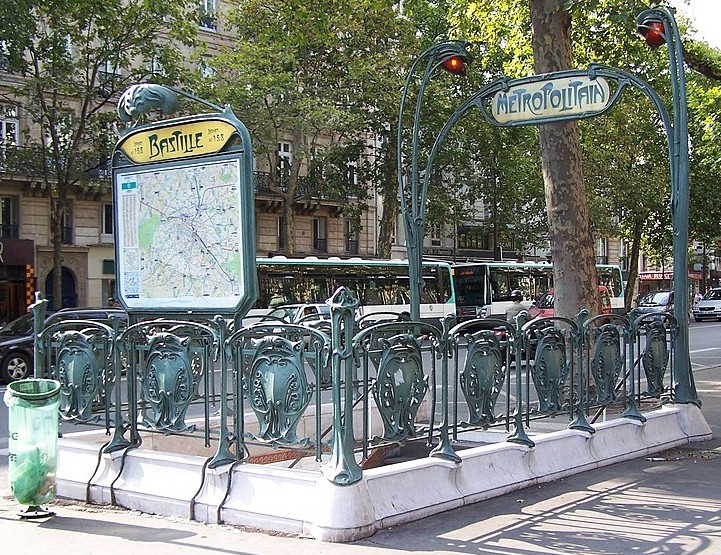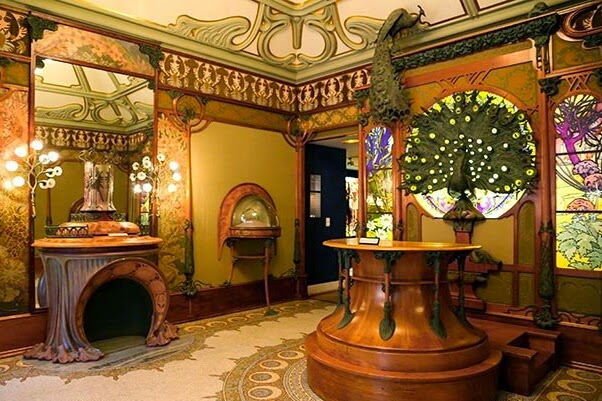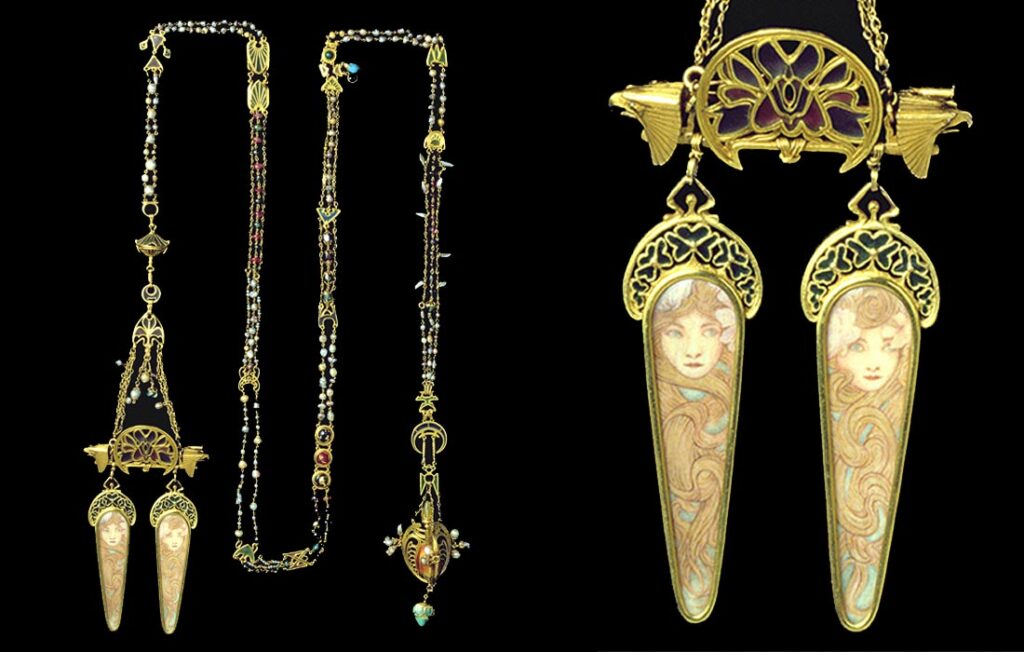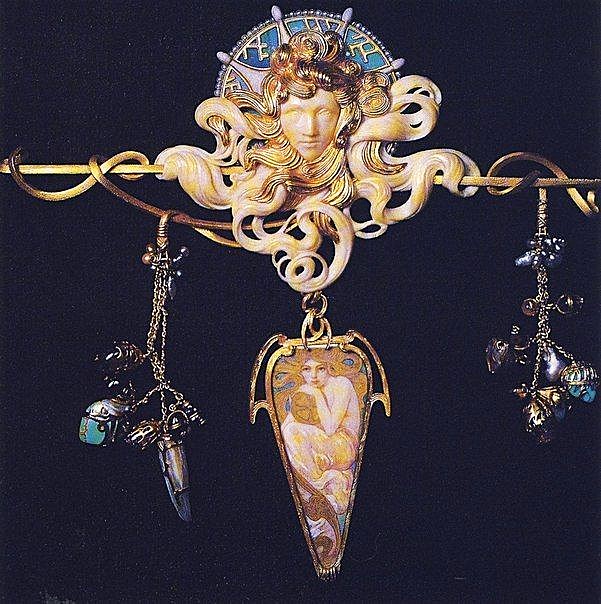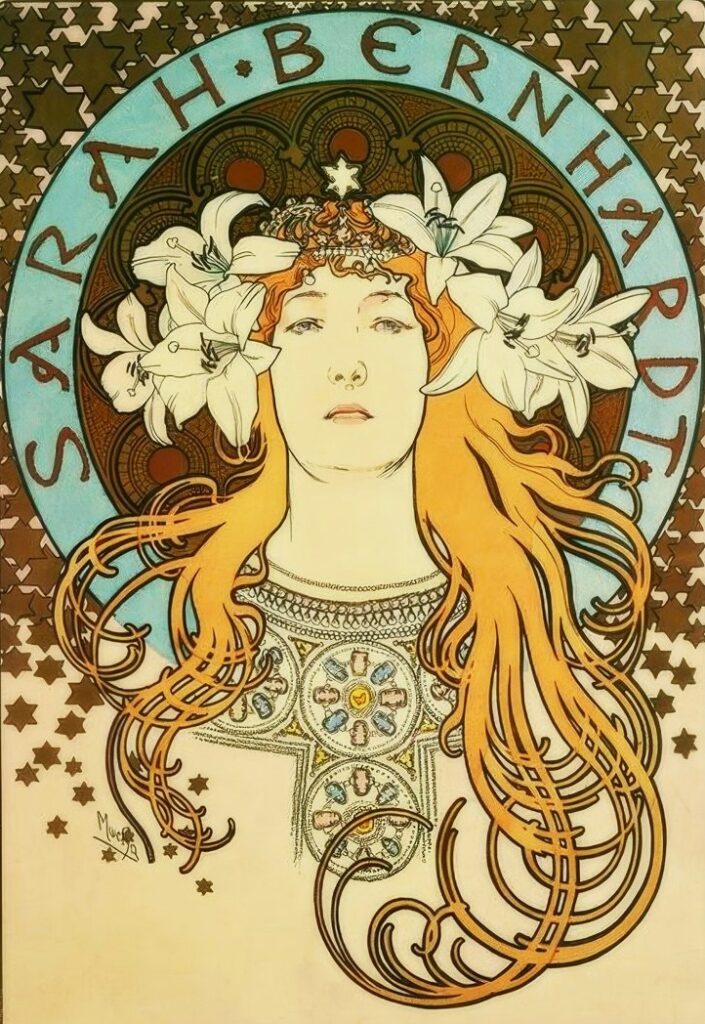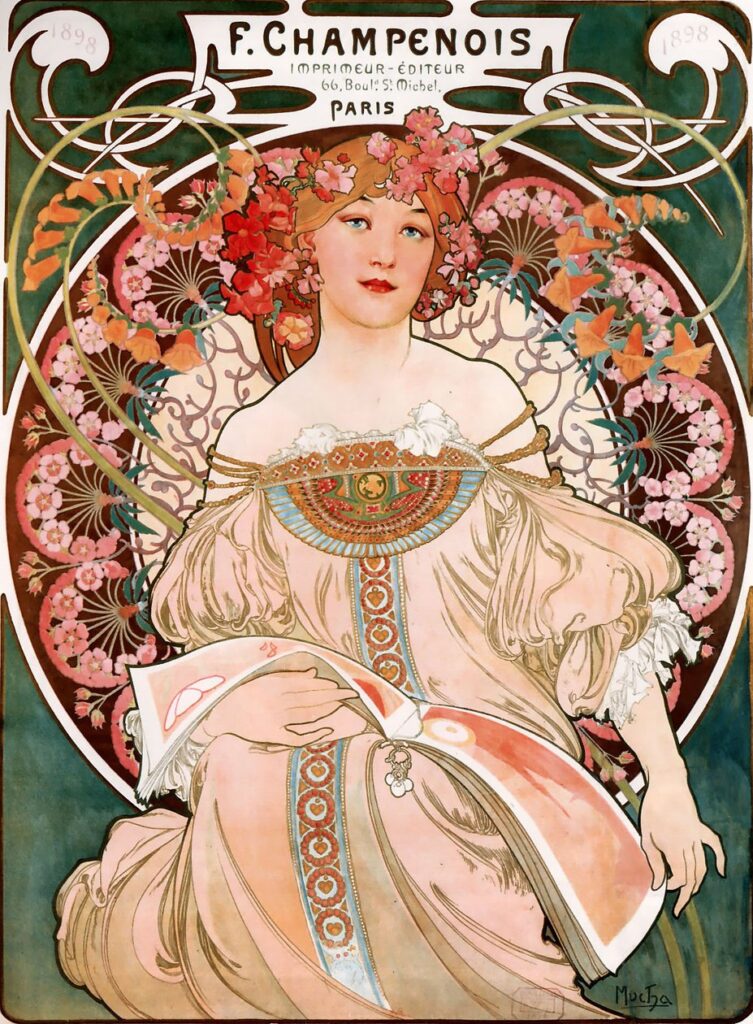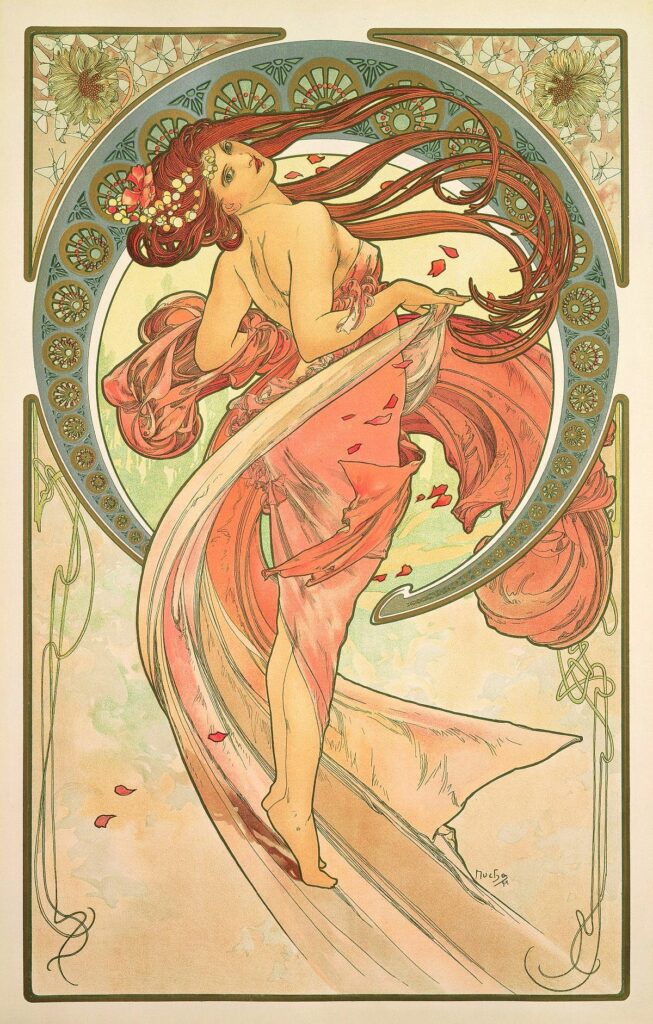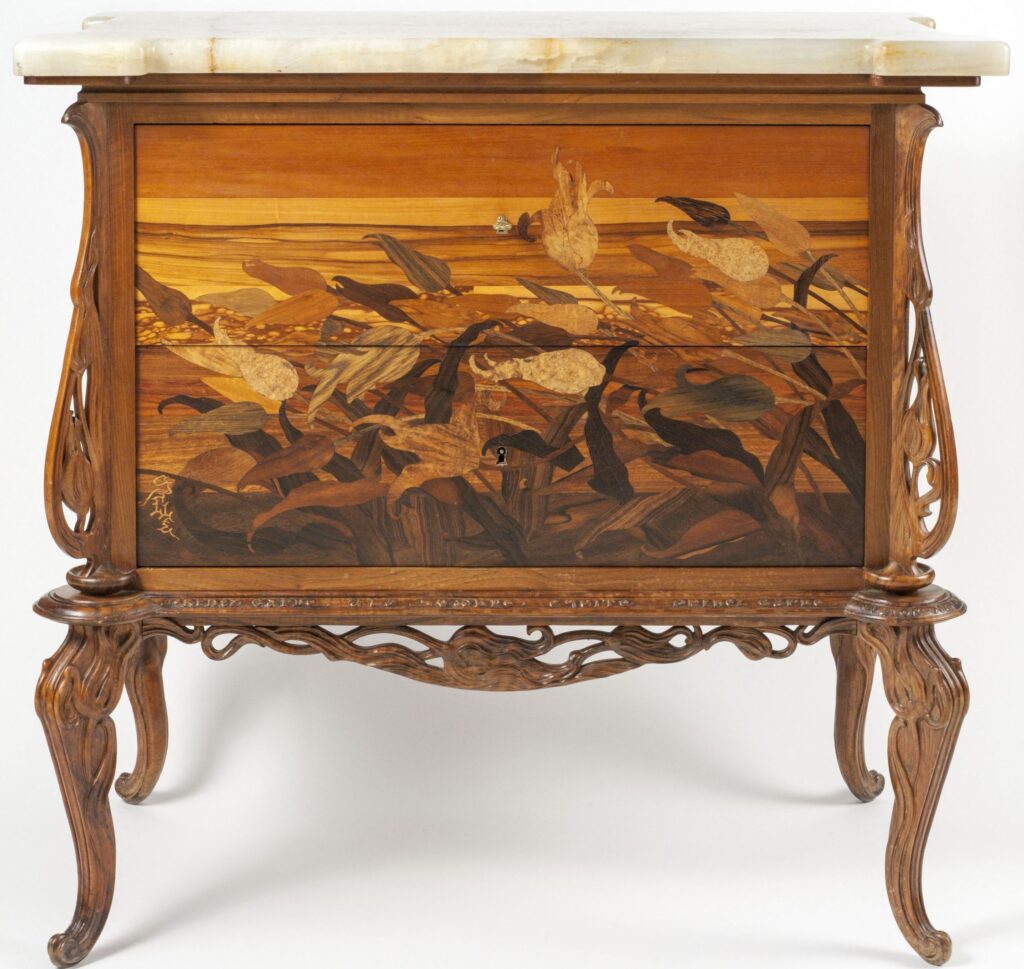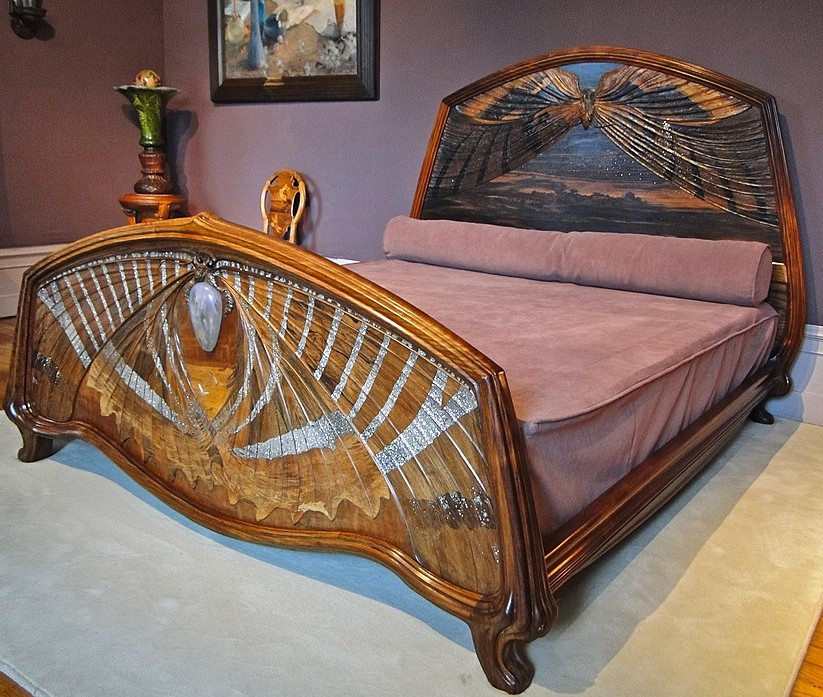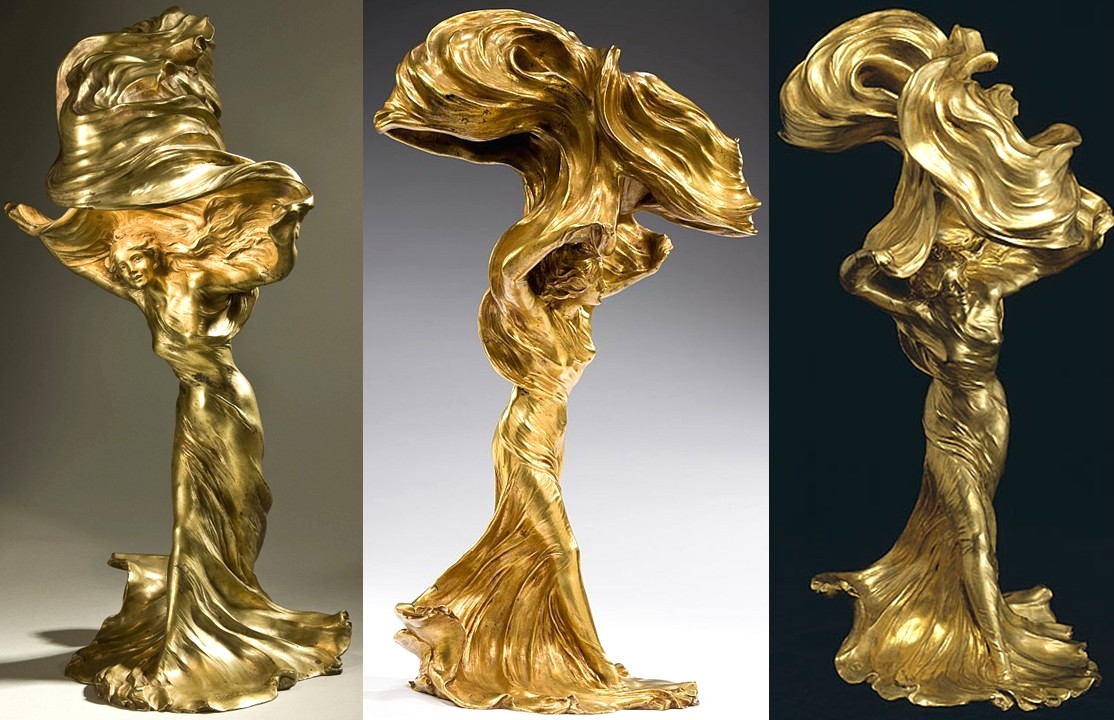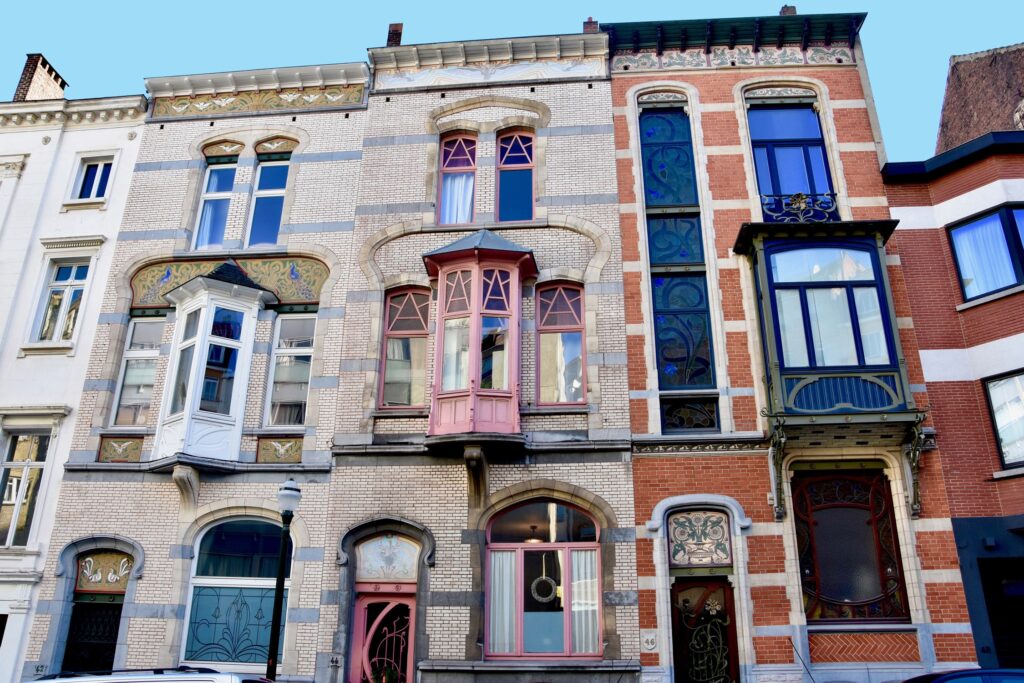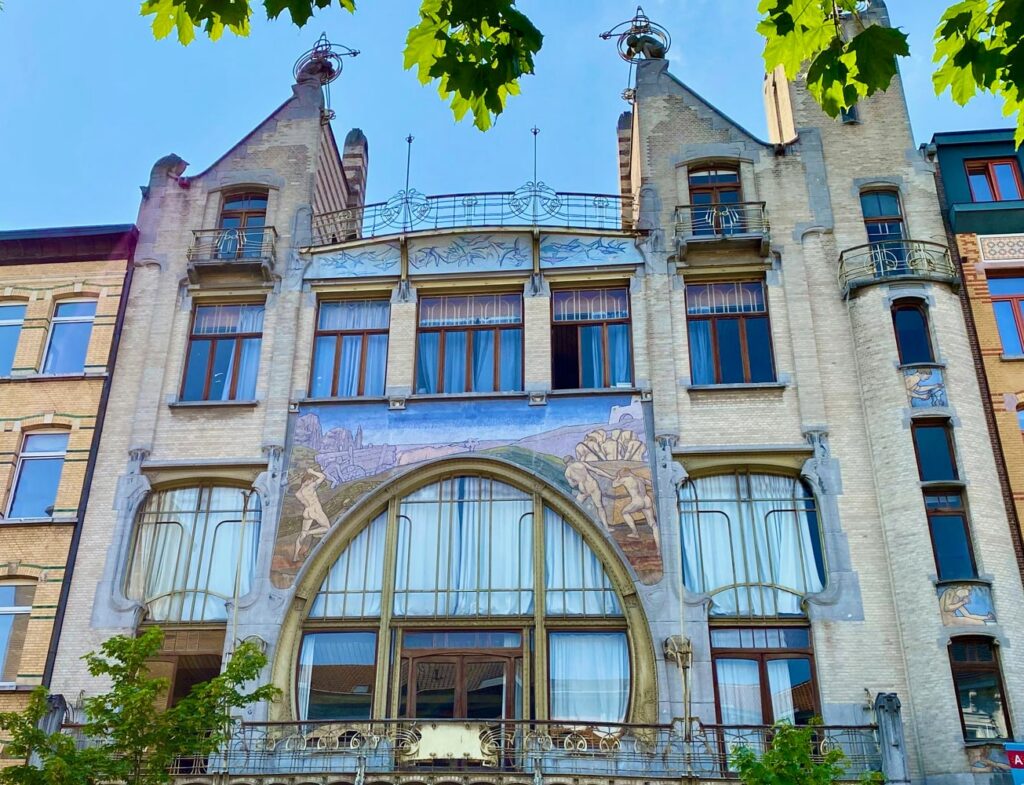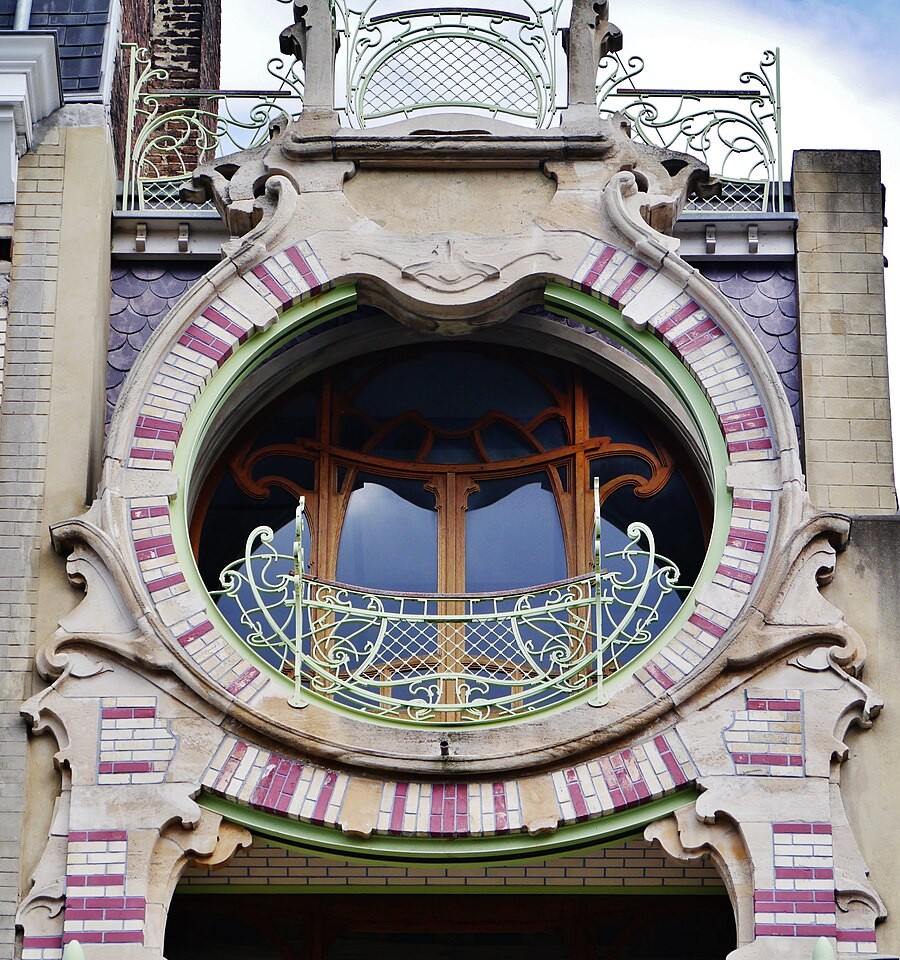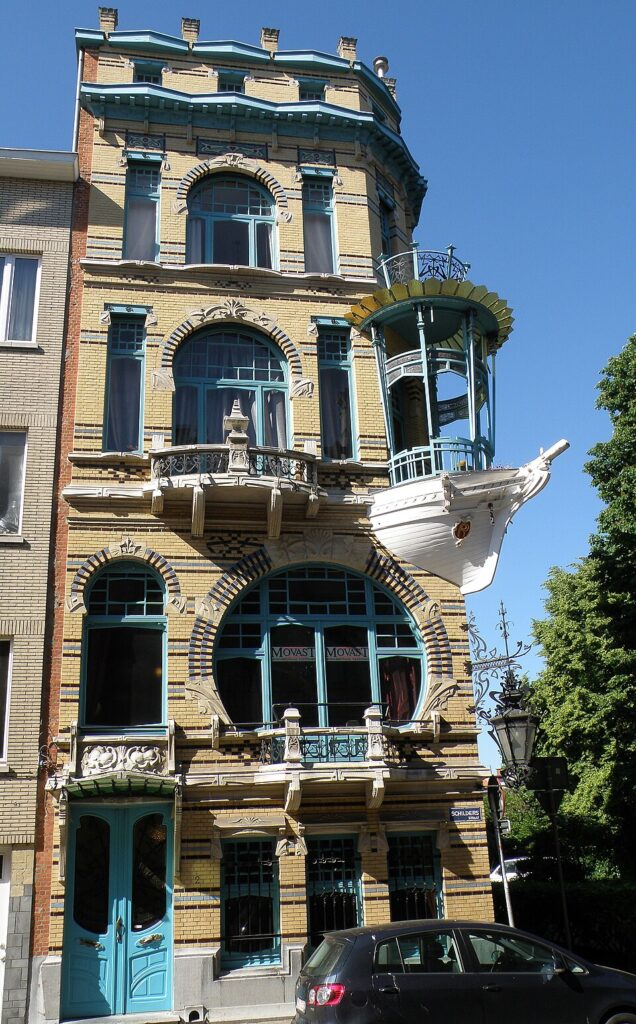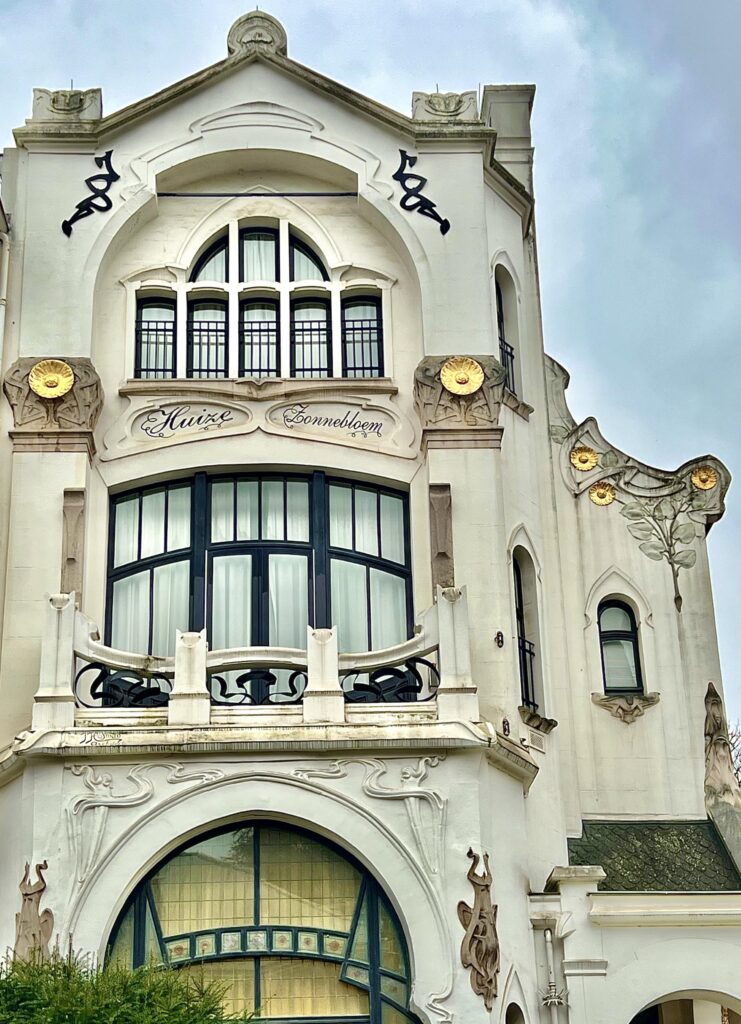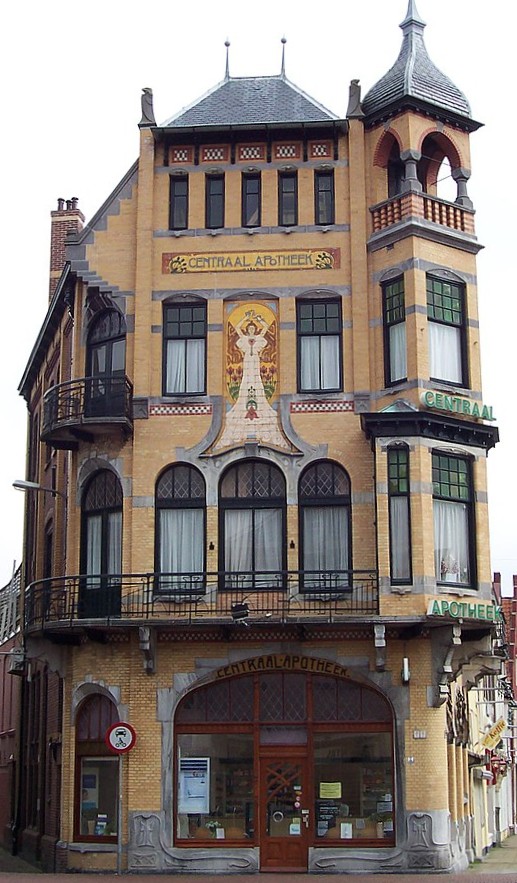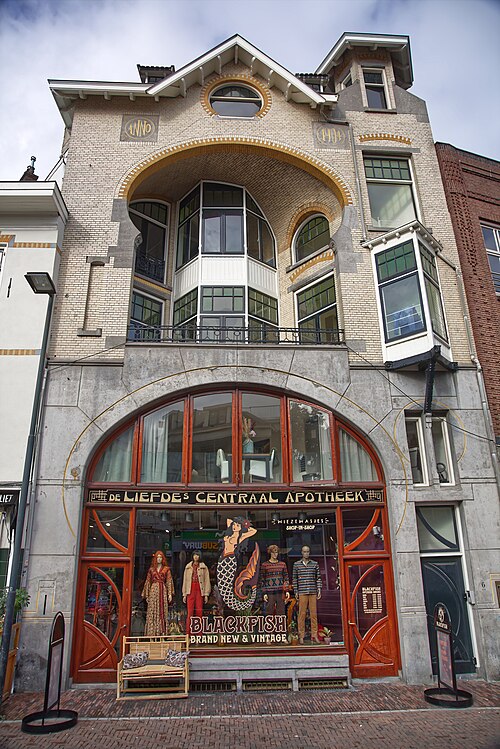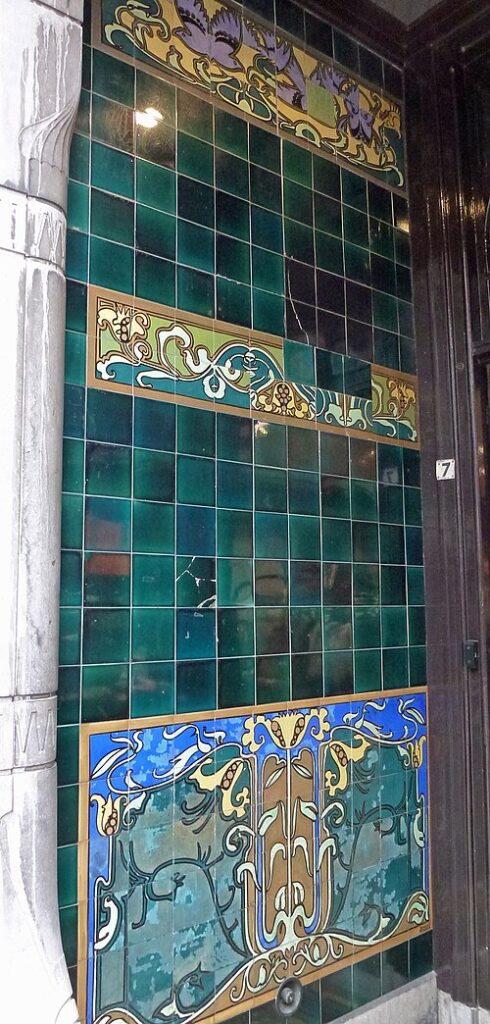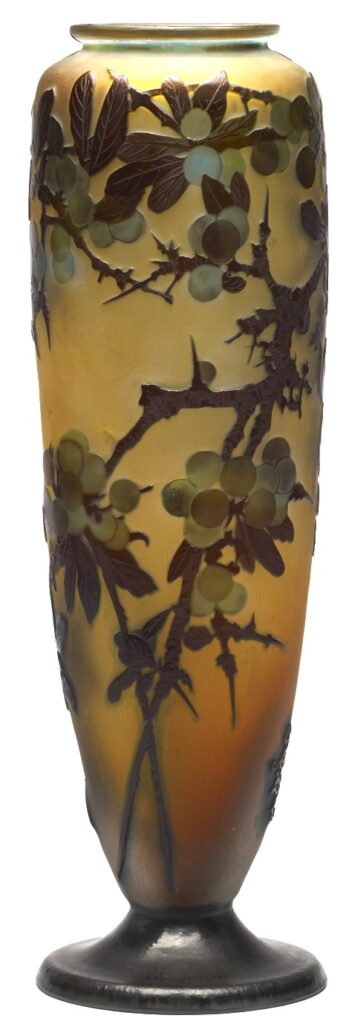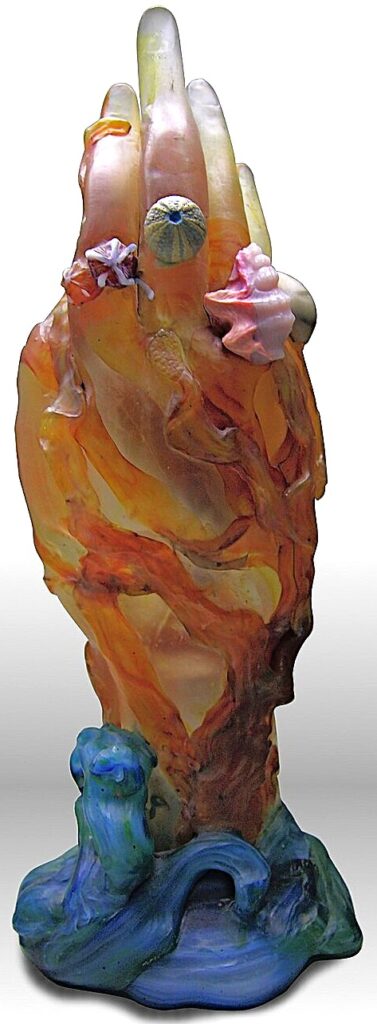Meta-Impressionism
Art-Nouveau
or: Jugendstil
the swirling line
Introduction:
Art-Nouveau is a broad art-movement which was on it’s peak at the Exposition Universelle in 1900. In Germany it was called Jugendstil. It was prominent in applied art, namely in architecture, furniture, jewelry, glassware en artistic posters and just partly in the fine arts. Important representatives were Alphonse Mucha, Louis Comfort Tiffany, René Lalique, Hector Guimard and Émile Gallé. The Art-Nouveau artists often used a swirling line (a wave, a curve, a swaying line). The stem of a plant was used as inspiration, therefore Art-Nouveau is also called the ‘stem style’ (R501,p77). The ritmic moving, winding line and the continuous movement of organic lines, is also called the ‘divine arabesque’ (R501,p82+84). Women with long waving hair are often depicted. The Art-Nouveau artists often used bendable metals, like cast iron and bronze (R501,p77;R511,p169).
This page is focussed on French artists and also on their contribution to the Exposition Universelle in 1900.
Art Nouveau at the Exposition Universelle in 1900:
Art Nouveau had a prominent place at the Exposition Universelle in 1900. Louis Tiffany↓ and his ‘Tiffany Glass and Decoration Company’ from the USA showed more than 100 pieces of glassware, windows, lamps, mosaics and enamels. Various works designed by Mucha were shown (see): the murals of the pavilion of Bosnia-Herzegovina (see); a poster for the Austria pavilion (see); menus (see); a statue for the Parisian perfumer Houbigant (see) and jewelry shown at the Fouquet stand (see). At the Decennial exposition he showed a sculpture (representing Austria).
Within groupe XII ‘Décoration et Meubilier…’ several Art Nouveau works were shown (R231-18). Within classe 67 (Vitraux) Louis Tiffany*↓ and his Company showed several (artistic) windows. Within classe 69 (Meubles) Gallé**↓ showed an office desk (M1) and other furniture. The Majorelle brothers and the Tiffany company also showed (artistic) furniture. Within classe 72 (Céramique) Dutch companies showed porcelain and ceramics, such as Rozenburg (from the Hague) and Distel (from Amsterdam) and also the designer Lambertus Nienhuis (R482). Within classe 73 (Cristaux, verrerie) vases of Émile Gallé**↓ were shown in his own ‘vitrine de verreries’ (no.26) (M1 +M1). The Daum brothers also showed glassware and crystal art (no.15**). The Tiffany company** showed glass mosaics; altars and accessories; mausoleums and monuments; artistic glassware (USA, no.16).
Within groupe XV (Industries diverses) also several Art-Nouveau art-works were shown (R231-19). Within classe 95 (Joaillerie et Bijouterie) Siegfried Bing↓ showed modern-style jewellery; ceramic and art glass works, titled “L’Art-Nouveau” (no.15). Georges Fouquet showed precious stones, jewellery and art objects (no.73), many of them designed by Mucha↓. René Lalique↓ (no.112) and the Tiffany company↓ (USA,no20) also were present.
Note*: received a golden medal (R231-13).
Note**: received a Grand Prix (R231-13)
The Siegfried Bing gallery:
Samuel Siegfried Bing (1838-1905) was an art-dealer, namely in Japanese and Asian objects. He had a gallery at 19, Rue Chauchat in Paris. (See the advertisement print of Henry Somm.) 1895/12/26 he opened a new gallery called ‘Maison de l’Art Nouveau’, 22 rue de Provence (iR3). This featured entire rooms designed in the Art Nouveau style, namely by Henry van de Velde↓ and Tiffany↓. Here he sold Art Nouveau objects till 1904. The building itself was destroyed in 1922.
At the Exposition Universelle in 1900 he had his own small pavilion, consisting of 6 rooms, which were designed by Georges de Feure (1868-1943), Eugène Gaillard↓ and Edward Colonna (1862-1948). It included a drawing-, dining- and bedroom. Bing was noted within classe 95 and showed modern-style jewellery and objects of ceramic and glass, labeled as “Art Nouveau” (no.15).
Sources: R501,p92-95+397; R511,p38+44; R3,p648; R231-19; iR3; iR6;
Henry van de Velde (1863-1957):
Henry van de Velde was a Belgian painter, architect, interior designer, and art theorist. As a painter he was influenced by Seurat and Signac and painted in a neo-impressionist style; he stopped painting in 1890. In 1889 he became member of Les XX. After 1892 he focussed on decorative art. He worked in Paris with Siegfried Bing↑, namely for his Art Nouveau gallery (1896) and his pavillion at the Exposition Universelle in 1900. He later became a major figure within the German Jugendstil.
Henry van de Velde didn’t received an award at the Exposition Universelle in 1900, within classe 69 (Meubles) (R231-13).
Sources: R504,p52-58; R501,p152-160+412; R369; iR3;
Eugène Gaillard (1862-1933):
Eugène Gaillard was an architect and designer for arts and crafts, namely for furniture. In his decorations he used plant and animal motives within erratic patterns.
Gaillard didn’t receive an award at the Exposition Universelle in 1900, within classe 69 (Meubles) (R231-13).
Sources: R501,p397; R511,p39-42; iR3; iR6;
Louis Comfort Tiffany:
Louis Comfort Tiffany (1848-1933) was born in New York. He is seen as one of the most popular and best glasswork artist in the Art Nouveau style. He studied painting in the studio of Leon Bailly in Paris (1868/9). Tiffany got inspired by Orientalism, stained glass windows and the Arts and Crafts Movement (with William Morris). First Tiffany had made landscape paintings, later he also did interior design. In 1879 he started he own company in decorative art in the USA. On a later trip in 1889 Tiffany was inspired by Venetian glass, iridescent glass from ancient Rome and by Gallé and his idea ‘art for all’. Tiffany made many stained glass windows, lamps, vases, jewellery, ceramics and other utility objects. He combined fine art and functional utility. He and his team developed several new methods, like favrile glass. He used many floral designs. In 1900 more than 1000 employees worked in the Tiffany studios. Tiffany was associated with the Bing (Art Nouveau) gallery.
Tiffany joined the Expositions Universelle in Paris in 1878 (with a street view). In 1900 he showed more than 100 pieces of glassware, windows, lamps, mosaics and enamels, within the classed 67 +69 +73 +95. He and his studio received a golden medal within classe 67 (Vitraux) and his studio also received a Grand Prix within classe 73 (cristaux, verrerie). Tiffany also exhibited at the Salon de la Société Nationale des Beaux-Arts in 1894 (glassware), 1895 (Favrille glassware and several windows), 1896/7 (Favrille glassware). And at the Salon de la Société des Artistes Français in 1905 +1906 +1913 +1914. He also exhibited at the World’s Columbian Exposition in Chicago (1893), Bing (1895/12 +1898/99), La Libre Esthétique (1897/8), the Grafton Gallery in London (1899), the International Exposition in Saint-Louis (1904).
Sources + more info + pictures: R505,p156-158; R501,p314-323+411; R506,p4-34; R511,p126-129; R231-7+13; iR3; iR6; iR8; Morse Museum (=M235); tiffany.com; .
See reviews on the 1900 expo: The Art Interchange, 44 (May 1900): The Tiffany display at Paris (R505,p95,note57); New York Mail & Express (1900/03/13); the Pittsburgh Dispatch (1900/03/17); The China Decorator (1900/04); The New York times (1900/04/20) (R505,p143).
The jewellery of Lalique:
René Lalique (1860-1945) is seen as one of the most celebrated artists of Art-Nouveau. In his early days he namely worked as a goldsmith. The use of unexpected materials rather than precious stones to make jewellery, such as ivory, enamel, horn and glass, is indicative of Lalique’s decisive role in transforming the art of jewellery (M103). 1908 onwards he became a celebrated glass artist.
Lalique had close contacts with Siefried Bing↑ and Alphons Mucha↓. He made tiaras for the actress Sarah Bernhardt and also a medallion (M1). Lalique exhibited at the Salon de la Société des Artistes Français, 1896 onwards, namely in 1897 (M1). At the Exposition Universelle in 1900 he showed about 100 art-works, namely jewelry, see M103 +M103; overview: M103; M6; .
Sources: R501,p87-90 +402; R511,p112+151-154+no286; R512; M103; iR4;
Paul and Henri Vever:
Paul (1851-1915) and Henri (1854-1942) Vever had taken over the jewelry shop of their father in 1881. Apart from Lalique they were the most important jewelers in Paris. At the Exposition Universelle of 1889 they received a Grand Prix. In 1900 they showed precious stones, jewellery and pieces of art within classe 95 (no.187); see M6.
Note: Henri Vever also was an important art-collector (iR6).
Sources: R501,p412; R231-19; iR3; iR4;
The ‘Style Métro’ of Guimard:
Hector Guimard (1867-1942) had received a travelling bourse in 1894 and went to England, Scotland (Mckintosh) and Belgium (Horta). He was commissioned to design the entries of the Paris metro (subway). The first line of the Parisian metropolitan rail network opened 1900/07/19 (iR3). Later he also designed entries for foreign subways (iR3). His popular style was called ‘Style métro’ (R501,p75). Guimard once said: “nature is the greatest architect and yet she doesn’t make anything that is parallel or symmetrical” (R501,p76)
Guimard also designed the Castel Béranger (16, Rue Jean de la Fontaine) and Hôtel Paul Mezzara (60, Rue Jean de la Fontaine). He also designed pieces of furniture.
Sources: R501,p75-82 +398; R505,p366-369; R511,p45-51+106+no302; iR3.
Georges Fouquet:
Georges Fouquet (1862–1957) took over the family business in 1895 en opened in 1900 a new jewelry shop at 6 rue Royale in Paris, designed by Mucha↓, close to the entrance of the Exposition Universelle, where his jewelry was shown. Mucha did the complete design, both interior and furnishings as well as the shop-front. The shop is now to be seen in the Musée Carnavalet (see; M8). He namely worked in the Art Nouveau style. In 1900 at the Exposition Universelle, he had his own stand, showing jewelry that was (partly) designed by Mucha↓. Fouquet was noted within classe 95 and showed precious stones, jewelry and art objects (no.73).
Sources: R501,p80+397; R511,p150/1; R231-19; iR3; M4; zilver.nl;
Alphonse Mucha:
Alphonse Mucha (1860-1939) was born in Bohemia, that is now part of the Czech Republic, but in those days a province of the Habsburg Austrian-Hungarian Empire (iR3). In 1888 he settled in Paris. From 1906-11 he lived in the USA. In 1911 he settled in Prague.
Mucha is namely famous for his posters for theatre performances. He received many commissions from the actress Sarah Bernhardt, for posters, theatre sets and costumes (1894-1900). Around 1900 Mucha was a prominent figure. He received many commissions for advertisement posters, calenders, menus, magazine titles and ‘panneaux décoratifs’. Namely the shop for Georges Fouquet↑. Mucha often depicted women with a dreamy gaze, flowing robes and long waving hair. He also made several series of posters, like on The (muses of) Art↓.
At the Exposition Universelle in 1900 various works designed by Mucha were shown (see): the murals of the pavilion of Bosnia-Herzegovina, for which he received a silver medal (see); a poster for the Austria pavilion (see); menus (see); a statue for the Parisian perfumer Houbigant (see) and jewelry shown at the Fouquet stand (see). At the Decennial exposition he showed a sculpture (representing Austria). In 1900 Mucha was at the height of his career in Paris as a versatile master of Art Nouveau (Jugendstil).
Sources: R507,p155-157; R501,p90-92+405; muchafoundation; driehausmuseum; iR155; iR3;
Émile Gallé (1846-1904):
Émile Gallé was a glass artist, ceramist and furniture designer. He is seen as one of the best glass designer of his time. He used a process for coated glass with sunken and relief-cut decoration. In 1874 he took over the family business. In 1891 he became member of the Société Nationale des Beaux-Arts.
Gallé regularly exhibited at the Salon de la Société Nationale des Beaux-Art, namely in 1891 (M1), 1892 (M1) and 1895 (M1). Gallé was succesfull at the Expositions Universelle in 1878, 1889 en 1900. Gallé received a Grand Prix at the Exposition Universelle in 1900, within classe 69 (Meubles) and within classe 73 (cristaux, verrerie) (R213-13).
Sources: R501,p398; R504,p66-70; R511,p10-21+113-120; M1 (selection); M1; iR23; iR4;
Daum brothers:
Jean-Louis-Auguste Daum (1854-1909) and Jean Antonin Daum (1864-1930) changed in 1891 the production of the family glassworks into the Art Nouveau style and founded the Atelier d’Art à la Verrerie in Nancy. In 1900 Henri Bergé was given charge of the design studio; in that year he received a Grand Prix at the Exposition Universelle. From 1905-30 Edgar Brandt and Louis Majorelle also worked for Daum. The firm used floral and abstract motifs for decoration.
The Daum brothers received a Grand Prix at the Exposition Universelle in 1900, classe 73 (cristaux, verrerie) (R231-13).
Sources: R501,p395/6; R511,p107+158/9; iR4; iR3.
Raoul Larche:
François-Raoul Larche (1860-1912) was a sculptor. At the Exposition Universelle in 1900, he received a golden medal. His most famous work is the gilded bronze table lamp depicting the swirling movement of the dancer Loïe Fuller (1862-1928) (iR4) performing here serpentine dance. A highlight in Art Nouveau!
Sources: R301,p402; R501,p101; R504,p11; R510,p8; R511,p110; iR3; iR4;
Art Nouveau (architecture) in Brussels:
Several architects designed Art Nouveau houses in Brussels: (R508,p113-145; R505,p369-374; R501,p131-161; iR3)
Paul Hankar (1859-1901): R501,p399; iR3;
*Hankar house (1893): 71 Rue Defacqz, Saint-Gilles, Brussels; (iR3; iR6)
*Hôtel Albert Ciamberlani (1897-98): Defacqzstraat 48, Elsene, Brussels; (R508,p121; R504,p44; R501,p140; iR3; iR6)
Victor Horta (1861-1947): iR3;
*Hôtel Tassel (1892-93): Paul-Emile Jansonstraat 6, Brussels; R508,p118; R504,p30+31+47; R501,p134+143; iR3; iR6;
*Hôtel Solvay (1895-1903): Avenue Louise 224, Brussels; (R508,p119; R504,p62/3; website; iR3; iR6)
*Hôtel van Eetvelde (1895-1901): Palmerstonlaan 4, Brussels; (R508,p131; R504,p60/1; R501,p137; iR3; iR6)
*Horta museum (1898-1901): former house and studio of Victor Horta; Amerikaansestraat 23-25, Sint-Gilles, Brussels; (R508,p122/3; R505,p371; R504,p58; R501,p136+141+143; R511,p73-75; website; iR3)
Gustave Strauven (1878-1919): (iR3)
*Saint-Cyr house (1901-03): Ambiorixsquare 11, Brussels; (R508,p129; R501,p145; iR3; iR6.)
Ernest Blérot (1870-1957): (R501,p393; iR3; admirable-artnouveau; facades)
*Bellevuestraat (1898-99), no.30 +32 +42 +44 +46; (R508,p136; facades; admirable-artnouveau)
*Huis Van Bellighen Tomberg (1899-1900): Louis Moricharplein 41; (R508,p127; admirable-artnouveau; facades)
Art Nouveau (architecture) in Antwerp:
Several architects designed Art Nouveau houses in Antwerp: R508,p146-165; R505,p369-374; iR3;
Frans Smet-Verhas (1851-1925): iR3;
*De vijf werelddelen (1901): Schildersstraat 2-6, Antwerp; R508,p158/9; erfgoed;
Jan van Asperen & Emiel van Averbeke:
*Liberaal Volkshuis “Help U Zelve” (1901): Volksstraat 40, Antwerp; R508,p157; R505,p372; iR3; iR6; admirable-artnouveau;
Jules Hofman: iR5;
Huize “Zonnebloem” (1900): Cogels-Osylei 50, Antwerp; R508,p152; R505,p371; admirable-artnouveau;
Other Art Nouveau houses:
Cogels-Osylei, no. 42 +44 +46 +50 +55 +59 +80; R508,p150-154;
Oostenstraat, no.28 +32 +34.
Transvaalstraat, no. 18 +30 +42 +52/54 +56 +62;
Waterloostraat, no. 2 +8 +10 +12 +14 +16 +18 +26 +28 +30; no. 11 +27 +31 +39 +49/51 +53 +55-63; R505,p371,no1249;
Art Nouveau architecture in Holland:
The Netherlands have many Art Nouveau buildings, or at least elements of it. Bé Lamberts has gathered it in a beautiful catalogue, including many detail pictures: Art Nouveau in Nederland; architectuur rond 1900 (2021=R505). See also de Bruijn & Schwartz (1992=R508,p21-111). Here below I render some examples.
Utrecht: rondom1900;
Rijk Rijksen (1872-1944): 1903-04, De Liefde Centraal Apotheek, Voorstraat 6 Utrecht; R505,p39,no59; R508,p77; iR5;
Leeuwarden: rondom1900;
Gerhardus Berend Broekema (1866-1946): 1904-05, Voorstreek 58, Leeuwarden; Centraal Apotheek; R508,p101/2; iR5; iR6;
Arnhem: rondom1900;
1902, Arnhem, Bakkerstraat 7a (detail porch); R505,p100,no84; R508,p97; iR6;
Zutphen: rondom1900;
H.J. van der Klip (?1875-1953): 1907, De witte toren, Deventerweg 89 Zutphen; R505,p45; R508,p109; RD;
See also Deventerweg 113 +115 +117.
Den Haag:
Jan Olthuis (1851-1921)?: 1900ca, Den Haag, Laan van Meerdervoort 215 ; R508,p49; iR5; iR6;
Plateelbakkerij Rozenburg, the Hague:
The Hague ceramics factory Rozenburg started in 1883. Important artistic leaders and designers were Théo Colenbrander (1841-1930) en Jurriaan Kok (1861-1919). Namely the eggshell porcelain was developed. Several of these ceramic objects were exhibited at the Exposition Universelle in 1900 (classe 72).
Sources: R501,p399+402; R502,p65-75 + 173-7; R231-18; R481; R482.
Old publications:
Here below you will find some old publications of or on the above mentioned artists:
Eugène Gaillard: A propos du mobilier. 1906. (R501,p397)
Eugène Grasset: La plante et ses applications ornamentales. 1896. (R501,p92)
Eugène Grasset: La méthode de composition ornamentale. 1905. (R501,p92)
Charles De Kay: The art work of Louis Comfort Tiffany. 1914 (R506,p30)
Alphonse Mucha: Documents décoratifs. 1902. (R501,p91)
Louis Comfort Tiffany: A partial list of windows. 1910ca. (R505,p157)
Sources:
My main sources on Art Nouveau in general are Fahr-Becker (1997=R501), Eliëns (2003=R502), Lamberts (2021=R503), Sembach (1991=R504), de Bruijn & Schwartz (1992=R508), Vitochová (1993=R509), Bossaglia (1973=R510), Buffet-Challié (1982=R511). Books on Tiffany (R505 + 506), Alphonse Mucha (R507) and Lalique (R512).
See the link for other general References (=Rx), to the internet references (=iRx) and Musea (=M). See links for practical hints and abbreviations and for the subscription of the paintings.
Additional references:
- MADparis.fr//bijoux (jewelry in the Musée des Arts Décoratifs in Paris of which some were exhibited at the Exposition Universelle in 1900; =M6)
- Pinterest (photos of Art Nouveau objects and architecture and objects, partly exhibited at the Exposition Universelle in 1900; =iR64)
- x
Recommanded citation: “Meta-Impressionism: Art Nouveau (Jugendstil); the swirling line. Last modified 2025/10/13. https://www.impressionism.nl/art-nouveau/”
